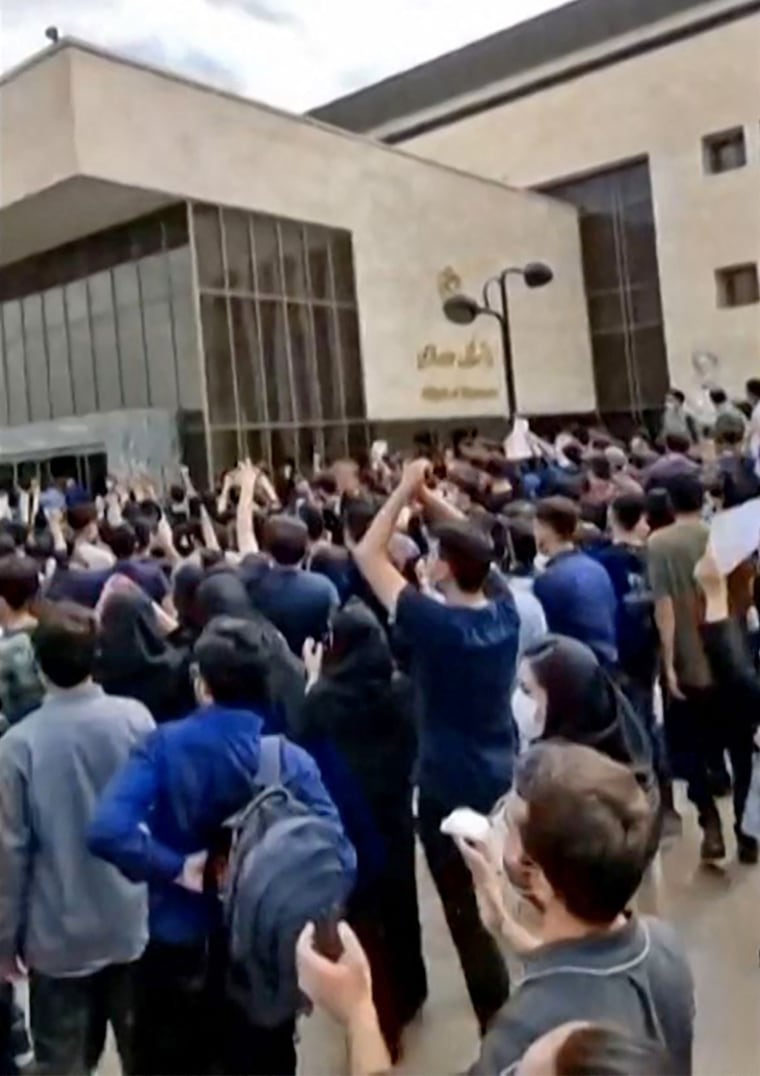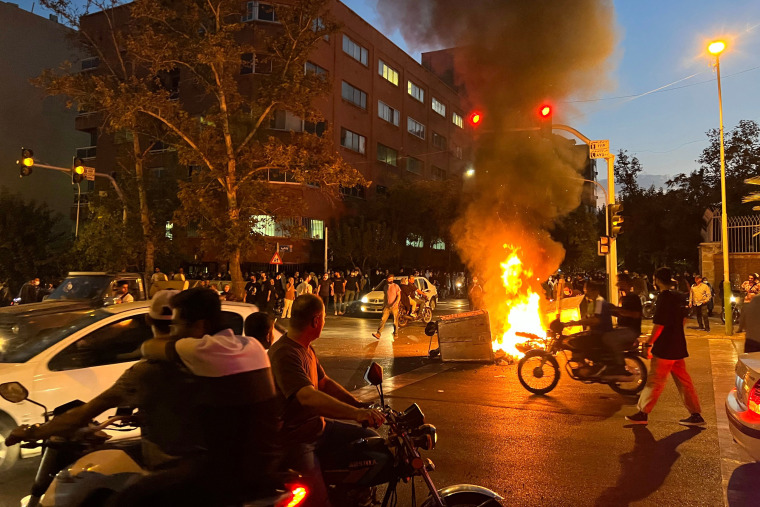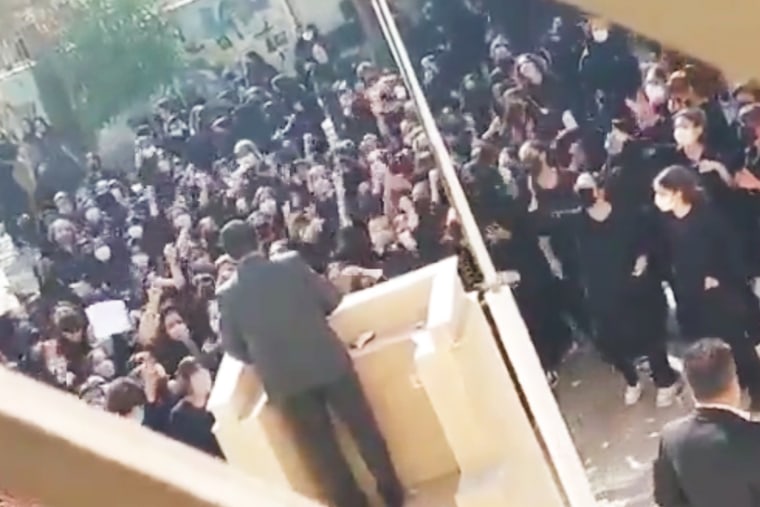Every night in Tehran, when the clock strikes nine, Iranians take to apartment rooftops and windows, and their voices echo across the city.
“Death to the dictator!” they shout, along with the slogan that has become the rallying cry of more than a month of protests, “Woman, Life, Freedom!”
“We chant every night from behind the window with the lights off, so we can’t get recognized or shot” by the police in the streets below, said one Iranian woman, who spoke on condition of anonymity to protect her safety.
The same chants can be heard in daily protests in cities and towns across the country, a wave of public anger that only seems to gain momentum even in the face of a violent crackdown by heavily armed security and paramilitary forces.

Since the protests erupted in mid-September after a 22-year-old woman, Mahsa Amini, died in the custody of the country’s morality police for allegedly failing to comply with a law requiring women to cover their hair, Iran’s clerical regime has struggled to contain a movement that keeps spreading and growing.
Every day seems to bring another humiliation for the regime.
From anti-government graffiti to students heckling government officials, to women walking in the street without headscarves to workers putting down their tools, Iran’s regime looks increasingly bewildered by events.
Historians who study Iran, human rights activists, political analysts, U.S. officials and Iranians on the ground all say the protests represent a potentially revolutionary moment, and that Iranian citizens are increasingly ready to risk their lives for the cause.
“It’s like a war, the Islamic Republic versus the Iranian people,” said the woman from Tehran. She and other Iranians say the helmeted police flooding the streets resemble an occupying force, unsure of their position and unable to trust the local population.
There have been major protests before, but the protests this time are different, Iranians say, because the movement transcends class and geography, and the demands are explicitly political, calling for an end to the regime and not reforms or higher wages.

“Every protest we’ve seen before has been limited geographically, or social-economically or related to a particular grievance,” said Hadi Ghaemi of the New York-based Center for Human Rights in Iran.
The “Green movement” protests of 2009 focused on an election that demonstrators believed was rigged and lasted months, but the movement was dominated by mostly educated, more affluent people in Tehran. Protests in 2019 were shaped by economic hardship and the frustrations of the working class, Ghaemi said.
“This is different. It seems to have touched every Iranian, in every corner of the country,” he said.
The protests have no formal leadership or opposition leader, making it difficult for the regime to cut off oxygen to the movement.
The protest are often smaller scale than the mass demonstrations of the past in major cities, but they are more numerous and dispersed across rural as well as urban areas. The security forces have to put down constant pockets of defiance in well-organized neighborhoods where the locals know where to hide and how to outmaneuver the police, human rights groups and Iranians said.
The demonstrators have even set up separate medical care for injured protesters in private homes to try to bypass official clinics, said Ramin Ahmadi, an Iranian-American physician based in the U.S. who is a longtime human rights activist.
“They don’t even go to the hospital when they get injured. There is a whole network of physicians now that they have and they treat them at home,“ said Ahmadi, who has provided medical advice by phone to the doctors treating the protesters.
But the regime has shown it is ready to unleash lethal force to stifle the protests, using live ammunition, buckshot, pellets, rubber bullets, tear gas and batons to roll back the demonstrators, according to human rights groups. Thousands of people have been arrested, including civil society and labor leaders, the rights groups say, and an unknown number have been killed by bullets or beatings.
The Norway-based group Iran Human Rights and the U.S.-based Human Rights Activists News Agency said Friday more than 250 protesters have been killed in the six weeks since protests began. The death toll includes more than 20 protesters under the age of 18, according to Amnesty International. Iranian authorities last month put the death toll at that point at 41 people, including security officers.
The regime has survived street protests before, by using violence, imprisonment and censorship to silence dissent. And the government still retains support among a significant section of the population, especially those with ties to the state’s bureaucracy.
The country’s Supreme Leader Ayatollah Ali Khamenei, who has the final word in Iran’s theocratic system, has dismissed the protests as “scattered riots” orchestrated by Iran’s enemies.
But the protests represent the most serious challenge to the theocracy since the 1979 revolution and its aftermath, and could mark the start of an unraveling of the regime — though that process could take months or years to play out, experts and U.S. officials said.

“There’s an increasing separation between state and society, and it’s widening under (Iranian President) Raisi’s administration,” a senior Biden administration official told NBC News.
The official said that “you have an erosion of the legitimacy of the system, that’s basically hanging on by threats of force.”
He added that “nobody can say for certain how this will unfold.”
Roya Hakakian, an Iranian-American writer who recently met with Biden administration officials along with other activists, said the protests were the start of a revolution “about democracy in its purest form — the desire for a normal life.”
“The cultural foundation is there and the shift from theocratic thinking to democratic thinking has already occurred, but when and how they will pragmatically succeed is a matter of time and the confluence of other forces,“ she said.

Despite the increasingly violent crackdown, Iranians — especially women — keep coming back to protest. The fear that tended to discourage open defiance of the regime has begun to dissolve, said Abbas Milani of the Freeman Spogli Institute at Stanford University.
“The fear is dissipating, because I think people are recognizing that from their large numbers, they’re not alone,” Milani said.
Seven years ago, Milani wrote that underneath a facade of normality, while most of the world focused on Iran’s nuclear program, Iranian society was shifting away from the ultra-conservative ideology promoted by the regime, and that its leaders were sitting atop a “seething volcano.”
“The trend line is that this regime is becoming increasingly isolated, increasingly misogynist, increasingly incompetent, increasingly corrupt, and Iranian society is becoming increasingly democratic, increasingly secular, and increasingly desiring an economic future that doesn’t exist,” Milani said. “That cannot continue.”
The Iranian government could decide to deploy even more lethal force to try to snuff out the protests, but there’s a risk such all-out violence — especially against young women — could backfire, and trigger a massive reaction on the streets, he said.
“I think we are at the beginning of a process. Iran has been in a revolutionary moment for some time, it needed a spark, we have to see where this will head,” said Ali Ansari, an Iran scholar at the University of St. Andrews in Scotland. “But even if this subsides it won’t be long before the next wave begins.”
For Iranians in the streets, there is a feeling they have the regime on the backfoot, but that there is still terrible bloodshed to come.
“We all know that this time we will overthrow the regime,” said the woman in Tehran. “But at what cost? How many people should get killed?”
